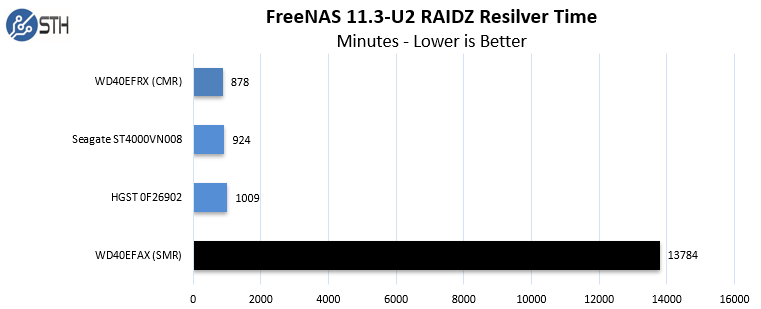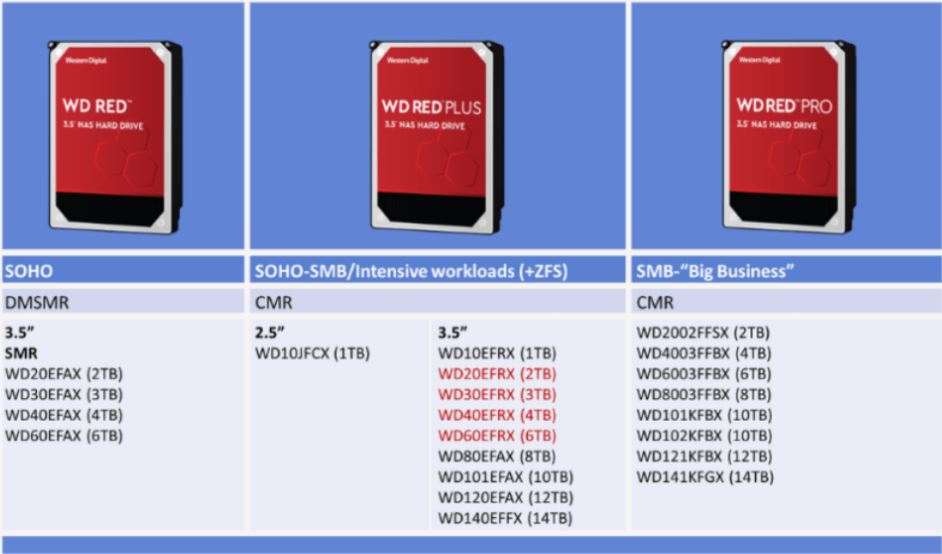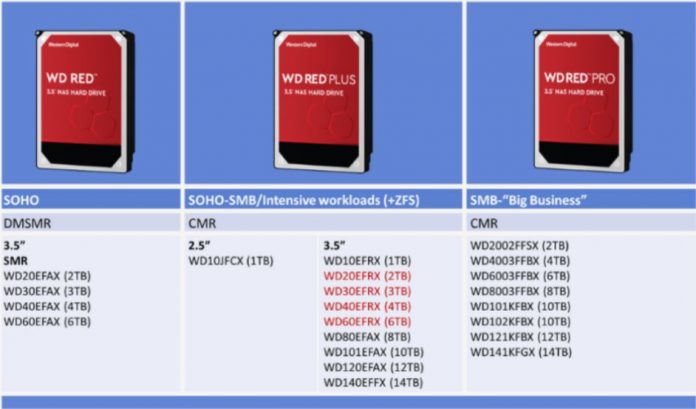After over two months of silence, Western Digital has a new update. The company is launching the WD Red Plus line. Indeed, I even got an e-mail alerting me to this update after it went live. The net impact is a positive step, but it is still not good enough to protect customers. The bottom line is this: we cannot recommend WD Red drives given the company’s direction. We are going into that below.
The Background of the WD Red DM-SMR Saga
In April, several reports of drive vendors Surreptitiously Swapping SMR into Hard Drive Lines Must Stop, giving credit here to Chris Mellor at Blocks and Files for leading an investigation, it was found that WD, Seagate, and Toshiba were all using drive managed SMR drives or DM-SMR/ DMSMR. The technology itself has its place, but the key is that drive vendors were doing this in lower-end and lower-cost segments. Those are precisely the users that may lack the knowledge, choice, and opportunity to make informed decisions on whether they want to use new DM-SMR or traditional CMR drives.
While all three vendors are using DM-SMR, Western Digital took it a step further, crossing a line Seagate said it was not crossing: using DM-SMR in their NAS drives. Specifically, a drive line we have long advocated for at STH, the WD Red line as we have used many drives over the years.
When we tested these drives in WD Red SMR vs CMR Tested Avoid Red SMR we found performance completely not fit for the purpose of being used in ZFS NAS arrays when we tested the solution using what is likely the most popular open-source NAS platform, FreeNAS (soon to be TrueNAS Core.)

To be fair, WD did not have an undisclosed swap of DM-SMR technology into the entirety of its new WD Red line. Instead, the company focused on the lower and lower-midrange of the market. In our third piece, we saw iXsystems, the company behind FreeNAS and TrueNAS abandon the new drives, as well as Synology. You can read more about that in: WD Red DM-SMR Update 3 Vendors Bail and WD Knew of ZFS Issues. In that piece, we also covered how WD had at least one current employee (via its HGST acquisition) that had even gone to a ZFS conference and discussed performance issues with DM-SMR and ZFS.
In that Update 3 piece, we also discussed the clear failure of WD and its partners’ test matrices for validating the new drives in NAS units. Part of the reason, we suggested, may be because WD did not clearly communicate this change while they were surreptitiously swapping SMR into hard drives. It may not just have been consumers.
Yesterday, I had a short bit in a piece that LTT did on WD facing class-action lawsuits over this behavior. Again, to reiterate, I think this is a functional silo issue at the company which allowed these drives to make it to market.
Today, WD has a response two months and a day after they last addressed the issue.
WD Red Plus Launched
Western Digital now has a new “WD Red Plus” line. Effectively, the company now has moved the DM-SMR to a traditional “WD Red” brand. The new “WD Red Plus” brand is the lower performance CMR line that incorporates the previous generation “EFRX” drives. Note: EFAX can mean either CMR (Red Plus higher capacity) or DM-SMR (2-6TB capacities).

Here is an excerpt from the press release on the new positioning.
- Our current device-managed shingled magnetic recording (DMSMR) (2TB, 3TB, 4TB, and 6TB) WD Red series will be the choice for the majority of NAS owners whose demands are lighter SOHO workloads.
- WD Red Plus is the new name for conventional magnetic recording (CMR)-based NAS drives in the WD Red family, including all capacities from 1TB to 14TB. These will be the choice for those whose applications require more write-intensive SMB workloads such as ZFS. WD Red Plus in 2TB, 3TB, 4TB and 6TB capacities will be available soon.
- Our WD Red Pro (CMR 2TB to 14TB) series for the highest-intensity usage remains the same. (Source: WD Blog accessed 6:35PM Pacific 23 June 2020)
Also, we wanted to point out that this was not a normal 6AM Pacific embargo brief. That slot went to our Ampere Altra Max coverage today, but there were a few other tech embargos at that time. Instead, I received the notice after this was live at 5:35PM Pacific. In other words, well after the day’s news cycle.
With the new line WD has effectively setup a new structure.
- WD Red is now a DM-SMR line. In the future, WD may continue to release DM-SMR NAS drives.
- WD Red Plus is now a CMR line as is WD Red Pro.
The issue still remains that users who have purchased WD Red drives in the past, and are not up on technology news nor current on what DM-SMR means, will continue to buy the “classic” WD Red brand. That is a huge portion of the potential buying population buying through the inertia of past habits.
By moving the DM-SMR drives to WD Red and CMR to WD Red Plus, WD is trying to capture that reflexive sales business driven by years of built brand equity. If you have a two-year-old NAS with WD Red CMR drives, why would you buy a WD Red Plus drive? The old ones have worked fine. That is exactly the mentality that WD is trying to capitalize on.
Those who have EFRX 2-6TB WD Red drives that are currently labeled “WD Red” are likely to buy “WD Red” again yet those new WD Red drives may not be fit for their purpose. Keeping the WD Red brand for substantially different drives is not good for the casual consumer.
WD also said: “Third-party testing also validates the performance of WD Red DMSMR drives compared with other drives under general hard drive benchmarks used in an NAS environment.” (Source: WD Blog accessed 6:35PM Pacific 23 June 2020)
WD did not cite the source of those benchmarks. The two big studies out there currently are our WD Red SMR vs CMR Tested Avoid Red SMR piece and Jim Salter’s Ars Technica piece. Since I am the editor for one of those two, I will simply say I would not say ours fully supports that statement. I would not say Jim’s piece fully supports that statement. I would also not say some of the end-user testing of NAS units with the DM-SMR drives supports that testing. We highlighted Rob Janssen’s personal blog (note currently HTTP) documenting his experiences with the WD Red DM-SMR drives in his Synology NAS. WD did not cite their sources, so we have no idea. It may be NAS vendor testing, but those same vendors, as well as WD’s testing, missed this in the first place.
Further, WD did not announce a streamlined program to help those who have WD Red DM-SMR drives, not fit for the purpose they were sold for, get on more appropriate hardware. We know there are STH readers impacted. The only advice we can give is to follow Rob’s path and try getting drives RMA’d. The after-sales support message was missing from today’s announcement.
On the positive side, WD is at least disclosing the use of DM-SMR technology. That is a great development. The company is also clearly specifying ZFS as not being suitable for WD Red drives. That is also a great development.
WD addressed the Synology NAS concerns and says it is working with vendors. Of note, we used Seagate IronWolf drives in our recent Synology DS920+ 4-Bay 1GbE NAS Review. After the stories we heard following our series, we cannot recommend the WD Red line. Red Plus and Red Pro are CMR, so they seem to still be OK.
Final Words
WD is releasing this news late in the afternoon, hoping most will not see it. WD is now officially calling WD Red a DM-SMR line, at least for now. Breaking it out is completely the right way to address this going forward. WD had a great thought here, but poor execution. By re-naming the DM-SMR line to WD Red, WD is in effect trying to sell less tech-savvy users or those who live in areas without the same extensive electronics distribution networks and purchasing power inferior drives hoping they will not notice.
If WD’s intention was not to mislead the average shopper who does not understand technical details of DM-SMR, it would have renamed the drives to something like “WD Orange” or “WD Peppermint” to avoid the confusion. By not doing this, WD seems to be going down a specific path.
To our readers, since WD Red is now synonymous with DM-SMR, we no longer recommend these drives. Please pass the word on so that users who do not have the knowledge, opportunity, or means to protect themselves do not end up purchasing these inferior hard drives. In the context of current environments, WD is doing the exact opposite of what movements to help people in those disadvantaged situations are aiming to accomplish. If people are making truly informed decisions within the context of options, that is perfectly reasonable to choose WD Red. As a tech community, we need to protect those who cannot. Although we have used older WD Red CMR drives for years, we can no longer recommend them to the millions of visitors to STH every year. It is up to our readers to help those who we cannot reach.





We’re doing an RFP for storage servers. We’ve told vendors no WD drives HDDs or SSDs because of how they’re handling this. They’re so big they won’t notice but it’s a five digit drive count loss for WD over the next 12 months given these configs.
What I’m more concerned about is price. If the Red Plus drives aren’t at the same price as the red drives were then this is really poor form from WD. They should be reducing the price on the DM-SMR drives and setting the red plus drives at the same price as the DM-SMR drives are now.
Honestly though they should get rid of DM-SMR in the red line and just tell those “light” users to use one of their cheaper drive lines anyway.
It’s funny, I just had a really long conversation with one of my VARs about this topic yesterday. His first question to me: What about the purple drives?
What they thinking? Is this 4 real?
They could’ve at least cited STH and ars. Basic thing you learnt in primary was coming sources. Third party? Where?
Wow, WD really has lost it, haven’t they? Devalueing the RED line entirely, in a time where the non-tech-savvy crowd is ditching HDDs entirely (because, let’s be honest, most people go for cloud options and not local NAS solutions), while the tech-savvy crowd that still buys their stuff can see what they’re blantantly doing. Might as well give up on the old spinners and focus on SSDs, if you’re going to roll like that, numpties!
@Nick Fusco
WD has confirmed that Purple drive still uses CMR. However, unlike the Red drives, The are only rated for the typical 10^14 URE (same as Blue, Black and Green), while Red are rated for 10^15 URE
@Western Disaster,
giving up old spinners and focus on SSDs… isn’t that more or less the background against which this event played out? SSDs are eating the market segment especially for lower-capacity HDDs. Short of exiting that market segment, there are only two options if you as a company want to remain profitable in a shrinking market with decreasing sales: Either increase sales prices, or find a way to reduce manufacturing costs of your products while maintaining or increasing sales prices. Obviously HDD manufacturers are attempting something along those lines in various ways. But WD thoroughly botched this attempt…
@Patrick, your write-up is stellar as always!
Thanks again for taking a stand on this issue!
I had hopes WD would by now have come to a proper solution.
Boy, was i wrong.
So now casual consumers will still be tricked into SMR REDs like you wrote, and all others will be now forced to pay an even bigger premium for their “Plus” line. And this while the price of NAS drives now is still as high as 3-4 YEARS ago!
I can only hope the class action lawsuit will make them regret this bitterly.
Seagate must be quite thankful to WDs incompetence. This happens when executives make business descisions with no clue for the market they operate in.
I love that ya’ll are taking a firm stance on this. It’s setting STH apart on storage just like servers and CPUs.
You’re talking impact instead of just saying the is of what is. You’ve backed the talk with testing.
And yeah who these 3rd parties?
SMR line should be WD Brown for the sh*t they are.
Bye bye WD
Hello Seagate.
If WD was so insistent on keeping the DM-SMR drives in the Red family banner (which WD REALLY shouldn’t do), the DM-SMR drives should have been rebranded as something like “Red Value”, leaving “Red” for the traditional CMR drives and “Red Pro” for the higher performance. Unfortunately, that’s too much rational thinking for the corporate execs. I’ve already voted with wallet and went the SSD route – non-WD SSDs at that.
Excellent work as always, @Patrick!
In my country we have not much options.
Thank Patrick. American that cares about others. Good man.
I also think that SMR drives shouldn’t be labeled as RED. If WD wants to use color as brand segmentation, then they shouldn’t call SMR drives RED at all. SMR drives should be BROWN. Avoid all confusion. Try to win back some good will. This course of action as helped me clarity any future purchases. STAY CLEAR OF WD is what this message has told me.
So WD will continue to screw over users who don’t know any better and just buy “WD Red”, and price-gouge users in the know for a premium on “WD Red Plus” drives. What a bunch of potatoes! I’ll be preferring Seagate wherever possible.
Op great comments on the decision.
TL;DR All they had to do was make a new line with dmsmr
So now we gotta go through all the “recommended NAS hard drive” search results and find all the old pages that advocate WD Red and contact the authors and get them to add “update: nevermind, WD is hellbent on confusing and screwing their customers” notes to the top of the articles.
The interesting thing is going to see what will appear in the shucked drives that WD ships out. Anything larger than 8TB appears to be ‘safe’…for now. There’s going to be a truck load of unhappy data horders come black friday getting DMSMR disks and the returns are going to be through the roof.
Forts of all, excellent article Patrick. As always of course, but I still have to say it.
Second, WD made wrong choice how to handle this. From the start they were not transparent at all, they said nothing about this. Now, just introducing Red Plus, what are they thinking!?
I am really not going to buy anything from them.
And it’s good to see that we as consumers are firmly sticking to this. We all have same opinion.
I’m still confused on what the recommendations are.
WD should have gathered up the DMSMR drives in a new color series based on a shade of RED.
In today’s horribly political environment that means PINK is out, but ORANGE would probably work.
Sarcasm or not?
@Jason
>I’m still confused on what the recommendations are.
Don’t buy anything DM-SMR for a NAS appliance. That means no WD Red.
WD Red Plus are safe, they are CMR. Ditto WD Red Pro.
If this has soured you utterly on WD, buy Seagate NAS Drives (Ironwolf) or Toshiba NAS drives (N300).
If you are lucking to “shuck” a WD external drive (such as Elements), make sure it’s 8TB or above so you’ll get CMR, and check beforehand whether WD has introduced DM-SMR in that capacity.
People over Profit. I’m tired of companies choosing to save a buck on the manufacturing even if it hurts the consumer.